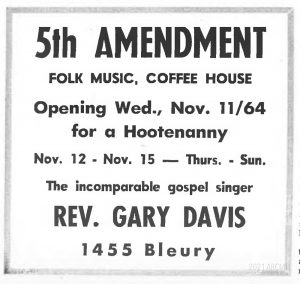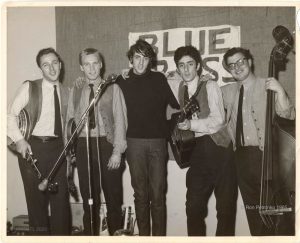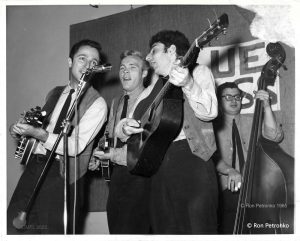The Origins of The New Penelope: The First Steps of a Visionary
Fifth Dimension
After returning to Montreal from his travels in America, 19-year-old Gary Eisenkraft found a job at the Fifth Dimension, a small coffeehouse on Bleury Street. He worked there with Mike Nemeroff, who would later pen several concert reviews in student newspapers. Gary helped the owners keep the place afloat and organized their “Hootenanny night.” A stable of many coffeehouses, Hootenannies were informal open-mic concerts. Folk singers and instrumentalists would often perform just for fun, in an improvised manner.
The fellas that own the Fifth Dimension are Stan Garfield and Morty Gollub. They alsa got these two fellas around the place who kinda help out. Their names ’r Mike Nemeroff and Gary Eisenkraft. Gary’s got a beard an’ he looks like one ’o them fellas ya’ see in Greenwich Village alla time. They got these here Hootenanny things evra Munday night an’ evrabuddy can raise Cain along with Gary who’s, I guess ya’ could call ’im, the head o’ the Hootenannies. [sic]
― Maurie Alioff, “The 5th Dimension”, The Georgian, vol. 27, no 13, February 4, 1964
Fifth Amendment
It’s in that same year, 1964, when young Gary Eisenkraft starts his entrepreneurial journey. At only 19 years old, he takes on the reins of The Fifth Dimension where he had started as a simple employee.

Article announcing the opening of the Fifth Amendment coffeehouse with full programming, November 3, 1964
Refurbished and renamed the Fifth Amendment, the place was ready to roll! With a few calls, Gary managed to add Montreal to the touring circuit of some notable folk and blues musicians, including artists like Reverend Gary Davis, Mike Seeger, John Hammond, Taj Mahal and Eric Andersen.
This was much to the delight of an elite of young musical connoisseurs in Montreal who revered these musicians.
I used to feel that I had a “manifest destiny” to bring music to Montreal. It was corny, but I believed it. (…) I was a kid when I opened the Fifth Amendment. (…) Only 17 and I knew nothing about business at all. At the time, music was the only thing that mattered – getting good music into Montreal. I didn’t care about bills, leases, debts – they just piled up and I said the hell with it – as long as the music is coming in.
― Gary Eisenkraft (interview for The Gazette newspaper, September 14, 1974)
Gary Eisenkraft also continued the Hootenannies’ tradition at the Fifth Amendment. He even expanded the programming to include concerts, film screenings, poetry readings, literary and dramatic numbers, live classical music and more. It reinvented the traditional coffeehouse model, offering much more than just coffee. Everything to entertain the gallery!
Yet, the space was too small to be profitable, so the Fifth Amendment closed barely five months later. Undeterred, Gary convinced the owner of the trendy Prag, on Bishop Street, to open a new coffeehouse next door. He named it The Penelope, after the goddess of chastity, whose likeness would go on to illustrate several of his concert posters. The Penelope adventure begins!
The Penelope
The Penelope coffeehouse was a small dimly-lit basement space that could seat 55 people, and up to 70 during performances. The hip and young teens and adults of the era were very enthusiastic about the music Gary was promoting.
I opened the place because I figured teenagers here have nowhere to go. They are pushed around and mistreated when they go out somewhere but we treat them with respect here.
― Gary Eisenkraft about The Penelope (interview for The Gazette newspaper, October 9, 1965)
A victim of its own success, the long lines on the street attracted the attention of the police. The Penelope was repeatedly raided by the police, which forced Gary to move again after only six months. This was the case with many other venues in the fast-moving Stanley Street scene in Montreal. Despite everything, Gary was never discouraged, and before long he was cooking up his next project…





